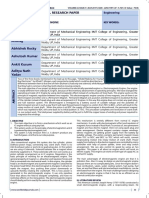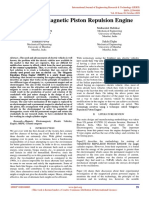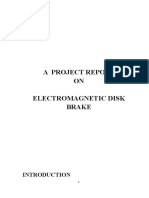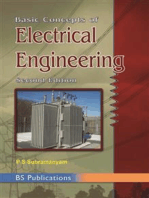A Review of Magnetic Repulsion Engine
A Review of Magnetic Repulsion Engine
Uploaded by
joy 11Copyright:
Available Formats
A Review of Magnetic Repulsion Engine
A Review of Magnetic Repulsion Engine
Uploaded by
joy 11Original Title
Copyright
Available Formats
Share this document
Did you find this document useful?
Is this content inappropriate?
Copyright:
Available Formats
A Review of Magnetic Repulsion Engine
A Review of Magnetic Repulsion Engine
Uploaded by
joy 11Copyright:
Available Formats
© 2017 IJEDR | Volume 5, Issue 1 | ISSN: 2321-9939
A Review Of Magnetic Repulsion Engine
1
N.G.Lokhande, 2 V.B.Emche, 3 V.M.Khanke
1
Lecturer, 2 Lecturer, 3 Head of the Department
1
Department of Mechanical Engineering, Shri Datta Meghe Polytechnic, Nagpur,India
________________________________________________________________________________________________________
Abstract – The prototype model namely ‘MAGNETIC REPULSION ENGINE’ is the engine works on the repulsion
principle of magnets. This engine is similar in construction as that of typical IC engine. t can be used to perform various
tasks and functions that involve application of force or displacement of objects. This method provides an environmental
friendly, very high efficiency engine that can complement or replace any engines that use fossil fuel, bio-fuel, solar power,
wind power, hydro power, electricity, storage energy, or other energy sources. It consists of one magnet fixed at the top
of the piston; the magnet is free to reciprocate along with the piston. The second magnet is fixed at the cylinder head. Both
the magnets are facing each other with like poles .These engine does not require any input source and works on the
magnetic force of its own ,thus it is eco-friendly and can be used in running automobiles ,industrial application, power
generation, etc. The engine can be best alternative for any type of fuel consumption engines.
Keywords: - Electromagnet, Ecofriendly, Repulsion
________________________________________________________________________________________________________
I. INTRODUCTION
Coal, petroleum, natural gas, water and nuclear energy are the five main energy sources that have played important roles and have
been widely used by human beings. Magnetic engines are defined as 2-phases engine which has no exhaust emission, higher
efficiency such characters are seen in these kinds of engines.
The prototype model namely ‘MAGNETIC REPULSION ENGINE’ is the engine works on the repulsion principle of magnets.
This engine is similar in construction as that of typical IC engine. It consists of magnet fixed at the top of the piston and another
magnet fixed at the piston head. Both the magnets are facing each other with like poles. These engine does not require any input
source and works on the magnet force itself, thus it is eco-friendly and can be applied in running automobiles, machines, power
generation, and many other applications. In future the field of application of the engine will widen.
Due to the rising fuel costs, environmental issues and diminishing natural fuel reserves, magnetic engine can become a workable
alternative to many existing engines. The main advantages of electromagnetic engine are that it is pollution free. Also it is easy to
design an electromagnetic engine because there are no complicated parts. Since the engine doesn’t have combustion, valves,
water cooling system, fuel pump, fuel lines, air and fuel filters and inlet and exhaust manifolds etc. can be eliminated from the
engine. The main challenge faced in designing an electromagnetic engine is that it has to be as efficient as an internal combustion
engine.
II. LITERATURE REVIEW
Our MAGNETIC ENGINE is inspired by the following inventions as follows;
Radhakrishna Togare who had invented ‘MAGNETIC PISTON ENGINE’ had mentioned about the running an engine with the
help of magnetism by using electromagnet and permanent magnet .
Sherman S. Blalock has mentioned in his ‘ELECTROMAGNETIC RECIPROCATING ENGINE’ about converting an IC engine
to an electromagnetic reciprocating engine by replacing the cylinder with nonmagnetic material and the piston replaced with
permanent magnet pistons. An electromagnet is disposed at the outer end of each cylinder whose magnetic field are used for
driving the piston.
Benjamin R. Teal who invented ‘MAGNETICALLY OPERABLE ENGINE’ has mentioned about a combination device for
developing a mechanical output from electrical energy which uses at least one electrical magnet solenoid and preferably a
plualirity of same. For controlling the time and degree of energization of electrical magnets , timing gears are used.
Mr. Manoj Gattani has invented ‘LINEAR MAGNETIC GENERATOR’. He mentioned about producing mechanical and
electrical output at same time hereafter referred to as a GOPI GEN . His objective for inventing this model is to provide a high
efficient ,zero emission is developed for power production which can lead the path of magnetic piston based alternative power
source.
Harold .L. Miller is an inventor of ‘PERMANENT MAGNET DRIVE APPARATUS AND OPERATIONAL METHOD’. His
invention concerns with reciprocating drive system that performs force and torque conversion by way of magnetic field
interaction in between permanent magnets. [1]
Electromagnet
An electromagnetic force is one of the four fundamental interactions of nature. Electromagnetism is the physical interaction
between electrically charged particles. As proposed by Sir J C Maxwell, there are majorly four electromagnetic interactions
present. First, the force of attraction and repulsion between electric charges is inversely proportional to the square of distance
between them. Second, magnetic poles always come in pairs, as electric charges do. Third, current flowing in a conductor
produces a magnetic field around it. Lastly a travelling electric field will produce a magnetic field, and vice-versa.
IJEDR1701064 International Journal of Engineering Development and Research (www.ijedr.org) 413
© 2017 IJEDR | Volume 5, Issue 1 | ISSN: 2321-9939
An electromagnet is a type of magnet which possesses the ability to magnetize and demagnetize as and when required. This
control is established by an electric current. When current flows, magnetism is expressed, and it vanishes when there is no flow of
current. When a wire is closely wound around a cylindrical object, the side faces of the core exert certain poles when current is
passed. The reversal of direction of current, changes the magnetic poles across the iron core. When electric current passes around
the core, there is and energy generation called magnetic flux. This magnetic flux is responsible for exerting the magnetic force.
Permanent magnets
These are the most common type of magnets that we know and interact with in our daily lives. E.g.; The magnets on our
refrigerators. These magnets are permanent in the sense that once they have been magnetized they retain a certain degree of
magnetism. Permanent magnets are generally made of ferromagnetic material. Such material consists of atoms and molecules that
each have a magnetic field and are positioned to reinforce each other.
Permanent Magnets can be classified into four types based on their composition:
1. Neodymium Iron Boron (NdFeB or NIB)
2. Samarium Cobalt (SmCo)
3. Alnico
4. Ceramic or Ferrite
NIB and SmCo are the strongest types of magnets and are very difficult to demagnetize. They are also known as rare earth
magnets since their compounds come from the rare earth or Lathanoid series of elements in the periodic table. The 1970s and 80s
saw the development of these magnets. Alnico is a compound made of ALuminium, NIckel and CObalt. Alnico magnets are
commonly used magnets and first became popular around the 1940s. Alnico magnets are not as strong as NIB and SmCo and can
be easily demagnetized. This magnet is however, least affected by temperature. This is also the reason why bar magnets and
horseshoes have to be taken care of to prevent them from losing their magnetic properties. Ceramic or Ferrite magnets are the
most popular today. They were first developed in the 1960's. These are fairly strong magnets but their magnetic strength varies
greatly with variations in temperature.Permanent Magnets can also be classified into Injection Molded and Flexible magnets.
Injection molded magnets are a composite of various types of resin and magnetic powders, allowing parts of complex shapes to be
manufactured by injection molding. The physical and magnetic properties of the product depend on the raw materials, but are
generally lower in magnetic strength and resemble plastics in their physical properties. Flexible magnets are similar to injection
molded magnets, using a flexible resin or binder such as vinyl, and produced in flat strips or sheets. These magnets are lower in
magnetic strength but can be very flexible, depending on the binder used.
Permanent magnets can be demagnetized in the following ways: - Heat - Heating a magnet until it is red hot, makes the magnetic
properties to fail - Contact with another magnet - Stroking one magnet with another in a random fashion, will demagnetize the
magnet being stroked. - Hammering or jarring will loosen the magnet's atoms from their magnetic attraction.[2]
III . CONSTRUCTION
A MAGNETIC REPULSION ENGINE consists of a non-magnetic cylinder, piston with connecting rod ,flywheel and crank shaft
arrangement ,and a pair of permanent magnets. The construction of these engine is similar as that of typical IC engine. Here ,the
spark plug and valves at the cylinder head is replaced by a permanent magnet. Another permanent magnet is placed at the top of
the piston which can freely reciprocates along with the piston. Both the magnets are arranged in such a way that there surfaces
are facing each other with like poles. Small openings are provided at the cylinder for natural air circulation.
IV. WORKING
As the name suggest, the MAGNETIC REPULSION ENGINE will work on the principle of magnetism. When the piston at the
BDC is provided with initial cranking effort ,it will move from BDC to TDC causing 180 o rotation of crank shaft. As the magnet
placed at the top of the piston and magnet fix at cylinder head are facing each other with like poles ,the repulsion force will start
acting on both the magnets . Minimum the distance between the magnets will cause higher repulsion force . Therefore when
piston reaches at TDC ,the repulsion force will repel the magnets and thus the magnetic piston will move downward from TDC
to BDC causing further 180o rotation of crank shaft and thus one complete rotation of crank shaft is obtained . After piston
reaches BDC the flywheel will pull the piston back towards TDC and thus cycle repeats. The engine will work on two stroke i.e
compression and power stroke. In this system, a permanent neodymium iron-boron magnet was adhered to the top surface of the
piston. Hence the magnet travelled along with the piston with reciprocating motion. So there were two magnets stuck to each
piston which reciprocated within the cylinder. The magnets were fixed in such a way that the pole orientation was in the same
direction. For e.g. if the south poles of both the magnets were fixed to piston surface, then the north poles were exposed to the
atmosphere.
IJEDR1701064 International Journal of Engineering Development and Research (www.ijedr.org) 414
© 2017 IJEDR | Volume 5, Issue 1 | ISSN: 2321-9939
V. WORKING DIAGRAM
VI. TECHNICAL SPECIFICATION
Sr. No. Component Qty. Material / Type
1. CYLINDER 1 CAST IRON
2. PISTON 1 ALUMINUM
3. CONNECTING ROD 1 CAST IRON
4. BELT 1 RUBBER
5. CRANK SHAFT 1 ALUMINUM
6. PULLEY 1 MILD STEEL
7. MAGNETS 2 NdFeB (N45)
VII. FUTURE SCOPE
As in present condition humans are heading toward the use of sources of energy which are pollution free and eco-friendly. Thus
the magnetic piston engine can be used as a better alternatives. It can be used to perform various tasks and function that involve
application of force or displacement of objects. This engine is highly efficient as it does not uses any input source and it works on
its own power. It has the possibility of reaching unity-over operation mode. It has the capability to replace the electric motors and
any engine which requires fuel burning to operate. As these prototype model consists of only one piston and only one pole of
magnet is used for running the engine,in future modification can be made to it by using two magnetic piston on both side of the
fixed magnet to make use of both the poles of magnet and to achieve high power and more effective use of magnets.
VIII. CONCLUSION
Hence, we have successfully and deeply learned about various types of magnets, their grades, power, availability, operating
condition, factors affecting magnet power and many more. We have also learned about the difference between theoretical concept
(i.e. design and working) and actual concept of the engine. Also, we learned about various difficulties arising during actual
construction of engine. Due to these project we got very important information related to magnets and various magnetically
operating engines and various efforts being made all over the world for developing an engine which are highly efficient, eco-
friendly and will run indefinitely.
REFERENCES
[1] Konduru Vasu 1 and Kalahsti Sirisha Vamsi “ Magnetic Piston Engine” Menta Sudheer1 *, , ISSN 2278 – 0149
www.ijmerr.com Vol. 3, No. 1, January 2014 .
[2] Ramanan.M1 balasubramanian.M2 ilaiyaraja.S3 “Experimental Investigation on Magnetized Piston Powered Engine”, , IOSR
Journal of Mechanical and Civil Engineering (IOSR JMCE) e ISSN: 2278-1684 p ISSN : 2320 334 PP 01 - 07
[3] Abil Joseph Eapen, Aby Eshow Varughese “Theory on electromagnetic engine.”
[4] Sumit Dhangar1, Ajinkya Korane2, Durgesh Barve3 “Magnetic Piston Operated Engine ” International Journal of Advance
Research In Science And Engineering http://www.ijarse.com IJARSE, Vol. No.4, Issue 06, June 2015.
IJEDR1701064 International Journal of Engineering Development and Research (www.ijedr.org) 415
© 2017 IJEDR | Volume 5, Issue 1 | ISSN: 2321-9939
[5] V. B. Bhandari, “Design of Machine Elements”, 3rd ed., McGraw Hill Education Pvt, Ltd., India, 2013
[6] P.C. Sen, “Modern Power Electronics”, 5thed, S. Chand & Co New Delhi, India, 2012
[7] H. C. Verma, “Concept Of Physics”, Bharati Bhavan, 2011
[8] Ramanan. M, Balasubramanian. M, and Ilaiyaraja. S, “Experimental Investigation on Magnetized Piston Powered Engine”,
IOSR-JMCE, 2014
[9] AmarnathJayaprakash, Balaji G., Bala Subramanian S. and Naveen N., “Studies on Electromagnetic Engine”, IJDR, 2014
[10]MentaSudheer, KonduruVasu and KalahstiSirishaVamsi, “Magnetic Piston Engine”, IJMERR, 2014
[11] Abil Joseph Eapen, AbyEshowVarughese, Arun T.P, and Athul T.N, “Electromagnetic Engine”, IJRET, 2014
[12] C. Sudhakar, K. Premkumar, K.Vijith, S.Balaji, “Emissionless Engine by using ElectroMagnet”, IJRAET, 2013
IJEDR1701064 International Journal of Engineering Development and Research (www.ijedr.org) 416
You might also like
- DOV 700-750 Series Repair Manual BRIGGS STRATTONDocument78 pagesDOV 700-750 Series Repair Manual BRIGGS STRATTONsua woschNo ratings yet
- Commissioning Procedure For A Boiler PDFDocument24 pagesCommissioning Procedure For A Boiler PDFpothan86% (7)
- Free Energy Generator Using Neodymium MagnetsDocument10 pagesFree Energy Generator Using Neodymium MagnetsJhumel Vallarta100% (3)
- Technical Data D2876LE301 2008 10 13Document3 pagesTechnical Data D2876LE301 2008 10 13George Domusciu67% (3)
- Study of a reluctance magnetic gearbox for energy storage system applicationFrom EverandStudy of a reluctance magnetic gearbox for energy storage system applicationRating: 1 out of 5 stars1/5 (1)
- Free Energy Magnetic Motor: A Project OnDocument4 pagesFree Energy Magnetic Motor: A Project OnEr Prem Princeps50% (2)
- RRLDocument7 pagesRRLDunhill Guantero75% (4)
- Simba L6CDocument4 pagesSimba L6CsasidharreddyNo ratings yet
- A Technical Seminar On Magnetic Repulsion EngineDocument14 pagesA Technical Seminar On Magnetic Repulsion EngineSrikanthNo ratings yet
- Magnetic Piston Operated Engine: Sumit Dhangar, Ajinkya Korane, Durgesh BarveDocument7 pagesMagnetic Piston Operated Engine: Sumit Dhangar, Ajinkya Korane, Durgesh BarveRahul YadavNo ratings yet
- A Review On Electromagnetic PistonDocument6 pagesA Review On Electromagnetic Pistonu2005044No ratings yet
- Haris ReportedDocument32 pagesHaris ReportedHaris GuardNo ratings yet
- Haris Done ProjectDocument41 pagesHaris Done ProjectHaris GuardNo ratings yet
- Free Energy GeneratorDocument9 pagesFree Energy GeneratorSridhar PatilNo ratings yet
- Magnetic Repulsion Piston Engine PDFDocument7 pagesMagnetic Repulsion Piston Engine PDFudayNo ratings yet
- BakyaDocument4 pagesBakyaBakkiyaraj MNo ratings yet
- EFMG22Document39 pagesEFMG22Fatima NoorNo ratings yet
- Phy 104 Lab ReportDocument6 pagesPhy 104 Lab ReportMd. Abdullah ZishanNo ratings yet
- journalsresaim,+IJRESM V3 I8 85Document4 pagesjournalsresaim,+IJRESM V3 I8 85Andreagale GoNo ratings yet
- Electrical Preventive MaitenanceDocument4 pagesElectrical Preventive MaitenanceUber AnsariNo ratings yet
- Investigatory Project PhysicsDocument12 pagesInvestigatory Project PhysicsjeevanNo ratings yet
- Electromagnetic EngineDocument62 pagesElectromagnetic EngineDeepak CNo ratings yet
- Magnetic Levitation Trains: Ankit PandeyDocument25 pagesMagnetic Levitation Trains: Ankit PandeyAshutosh MishraNo ratings yet
- Design and Analysis of Magneto Repulsive Wind TurbineDocument7 pagesDesign and Analysis of Magneto Repulsive Wind TurbineIJSTENo ratings yet
- Original Research Paper: EngineeringDocument3 pagesOriginal Research Paper: EngineeringChristian DavidNo ratings yet
- Chapter 1Document10 pagesChapter 1Reydale Cacho100% (1)
- Free Energy GenerationDocument8 pagesFree Energy GenerationKamlesh Motghare100% (4)
- Magnetic Levitation Turbine Electricity Generating SystemDocument4 pagesMagnetic Levitation Turbine Electricity Generating SystemIrish MendozaNo ratings yet
- Permanent and Temporary Magnetic GeneratorDocument2 pagesPermanent and Temporary Magnetic GeneratorIJEID :: www.ijeid.com100% (1)
- Project-Electromagnetic Engine 1Document15 pagesProject-Electromagnetic Engine 1Aditya samalNo ratings yet
- Hidayat 2019 J. Phys. Conf. Ser. 1402 033100Document7 pagesHidayat 2019 J. Phys. Conf. Ser. 1402 033100Aleksa RancicNo ratings yet
- Physics ProposalDocument4 pagesPhysics ProposalPJ CollamarNo ratings yet
- SANDY PPT - pptx123Document35 pagesSANDY PPT - pptx123Naresh DamaNo ratings yet
- Aspden - Power From Magnetism - Over-Unity Motor Design (1996)Document31 pagesAspden - Power From Magnetism - Over-Unity Motor Design (1996)Fried M. KhanNo ratings yet
- Magnetic Repulsion EngineDocument18 pagesMagnetic Repulsion EngineDarshan bsNo ratings yet
- Automatic Magnetic Motor Free Energy Generator: PG Scholar, EEE, PRIST UniversityDocument11 pagesAutomatic Magnetic Motor Free Energy Generator: PG Scholar, EEE, PRIST UniversityCris VillarNo ratings yet
- MAGNETIC LEVITATION TRAIN SynopsisDocument16 pagesMAGNETIC LEVITATION TRAIN SynopsisAnuj TripathiNo ratings yet
- Jovan Marjanovic Basic Principles of Overunity Electro MachinesDocument23 pagesJovan Marjanovic Basic Principles of Overunity Electro Machinesimpulse787100% (1)
- Design and Fabrication of Electromagnetic EngineDocument3 pagesDesign and Fabrication of Electromagnetic EngineSURAJNo ratings yet
- Experiment 4 Simple MotorDocument6 pagesExperiment 4 Simple MotorKim HarlyNo ratings yet
- Amar SpinDocument24 pagesAmar SpinmanushpareekNo ratings yet
- Visvesvaraya Technological University: Submitted in Partial Fulfilment of The Requirements For The Award of DegreeDocument15 pagesVisvesvaraya Technological University: Submitted in Partial Fulfilment of The Requirements For The Award of DegreeLohitNo ratings yet
- Chapter 1: Magnet Power: Shenhe Wang'S Permanent Magnet MotorDocument52 pagesChapter 1: Magnet Power: Shenhe Wang'S Permanent Magnet MotorMayki ChiNo ratings yet
- DC MotorDocument34 pagesDC MotorDhana Delosreyes100% (2)
- JRNL Electromagnetic Shock AbsorberDocument3 pagesJRNL Electromagnetic Shock AbsorberMohammed FayisNo ratings yet
- Electromagnetic and Magnetic Suspension: IJEDR1703070 474Document8 pagesElectromagnetic and Magnetic Suspension: IJEDR1703070 474Naani ChowdaryNo ratings yet
- A Study of Magnetic Piston Repulsion Engine IJERTV10IS100003Document4 pagesA Study of Magnetic Piston Repulsion Engine IJERTV10IS100003Ananthu SomanNo ratings yet
- The Magniflux Shuttle: Physics Investigatory ProjectDocument12 pagesThe Magniflux Shuttle: Physics Investigatory Projectsonesh kumar swainNo ratings yet
- InglesDocument11 pagesInglesEddy MusicNo ratings yet
- Minor Project Report MechanicalDocument26 pagesMinor Project Report MechanicalVaibhav Soni82% (28)
- Electromagnetic EngineDocument2 pagesElectromagnetic EnginevishalmisalNo ratings yet
- Design Optimization of A Solenoid-Based Electromagnetic Soft Actuator With Permanent Magnet CoreDocument5 pagesDesign Optimization of A Solenoid-Based Electromagnetic Soft Actuator With Permanent Magnet CoreVinit MhatreNo ratings yet
- Build A Simple Motor ActivityDocument4 pagesBuild A Simple Motor ActivityAngelica Calamba CalicaNo ratings yet
- Electromagnetic - Disk - Brake RDocument70 pagesElectromagnetic - Disk - Brake RPrints BindingsNo ratings yet
- Synopsis On Electromagnetic Car PDFDocument3 pagesSynopsis On Electromagnetic Car PDFyrikkiNo ratings yet
- Synopsis: Design and Fabrication of Solenoid EngineDocument3 pagesSynopsis: Design and Fabrication of Solenoid EngineJiteshNo ratings yet
- Super Magnet Braking System (Report) PDFDocument57 pagesSuper Magnet Braking System (Report) PDFsrinivasarao katari100% (2)
- Small Dynamos and How to Make Them - Practical Instruction on Building a Variety of Machines Including Electric MotorsFrom EverandSmall Dynamos and How to Make Them - Practical Instruction on Building a Variety of Machines Including Electric MotorsNo ratings yet
- INSTALL YOUR OWN Photovoltaic System: Hybrid, Stand Alone and Battery StorageFrom EverandINSTALL YOUR OWN Photovoltaic System: Hybrid, Stand Alone and Battery StorageNo ratings yet
- Home-made Toy Motors: A practical handbook giving detailed instructions for building simple but operative electric motorsFrom EverandHome-made Toy Motors: A practical handbook giving detailed instructions for building simple but operative electric motorsNo ratings yet
- How Do Electric Motors Work? Physics Books for Kids | Children's Physics BooksFrom EverandHow Do Electric Motors Work? Physics Books for Kids | Children's Physics BooksNo ratings yet
- Basic Concepts of Electrical EngineeringFrom EverandBasic Concepts of Electrical EngineeringRating: 5 out of 5 stars5/5 (1)
- Datasheet On Gaothans in Navi MumbaiDocument2 pagesDatasheet On Gaothans in Navi Mumbaijoy 11No ratings yet
- Te-Mech Sem5 Tom2 May19Document2 pagesTe-Mech Sem5 Tom2 May19joy 11No ratings yet
- Sales Manager: About Role at Whitehat JRDocument2 pagesSales Manager: About Role at Whitehat JRjoy 11No ratings yet
- Tyroller e 20170207 PDFDocument1 pageTyroller e 20170207 PDFjoy 11No ratings yet
- Curriculum Vitae: Peter TyrollerDocument1 pageCurriculum Vitae: Peter Tyrollerjoy 11No ratings yet
- X500 Server: Fully Rugged Mobile ServerDocument2 pagesX500 Server: Fully Rugged Mobile Serverjoy 11No ratings yet
- V4i3 1616 PDFDocument6 pagesV4i3 1616 PDFjoy 11No ratings yet
- List of Incubators Supported by DST: Mr. Tom Thomas Coo Prof. Vasudeva Varma Dean RND and CeoDocument41 pagesList of Incubators Supported by DST: Mr. Tom Thomas Coo Prof. Vasudeva Varma Dean RND and Ceojoy 11No ratings yet
- Name of National Coordinator Course Objectives (What You Will Learn?)Document70 pagesName of National Coordinator Course Objectives (What You Will Learn?)joy 11No ratings yet
- Low Power Stirling Engine For UnderwaterDocument6 pagesLow Power Stirling Engine For UnderwaterVladimirDvortsovNo ratings yet
- Chapter - 3 Experimental Setup and Test ProcedureDocument22 pagesChapter - 3 Experimental Setup and Test Procedurejaiy12No ratings yet
- SteamTurbineanalysisms KumanaIETC20173 27 17Document9 pagesSteamTurbineanalysisms KumanaIETC20173 27 17Vivek DomadiyaNo ratings yet
- Super GlossDocument1,519 pagesSuper GlossIvan Pinto33% (3)
- Final ProjectDocument7 pagesFinal ProjectLarweh DanielNo ratings yet
- Fire Pump SeminarDocument29 pagesFire Pump SeminarevaneliasibNo ratings yet
- Automotive CBCDocument75 pagesAutomotive CBCEdgardo RicaldeNo ratings yet
- Module 15 TAI - TC.MTO Basic Knowledge Examination Summary DataDocument79 pagesModule 15 TAI - TC.MTO Basic Knowledge Examination Summary DataChatchai PrasertsukNo ratings yet
- Ross Macmillan Intro - Chapter 1Document25 pagesRoss Macmillan Intro - Chapter 1Kartik ModiNo ratings yet
- Diesel Generator Set: Output RatingsDocument9 pagesDiesel Generator Set: Output Ratingsjude tallyNo ratings yet
- Design and Optimization of A Drivetrain With Two-Speed Transmission For Electric Delivery Step VanDocument21 pagesDesign and Optimization of A Drivetrain With Two-Speed Transmission For Electric Delivery Step VanAlexei MorozovNo ratings yet
- Grundfos Sqe SeriesDocument40 pagesGrundfos Sqe Seriesd2ana79No ratings yet
- 2 LER Specifikacija GMDocument6 pages2 LER Specifikacija GMMarino CondicNo ratings yet
- Light Tower: MLT4060M - MLT4060K MLT4080M - MLT4080KDocument56 pagesLight Tower: MLT4060M - MLT4060K MLT4080M - MLT4080Ka_edmundoNo ratings yet
- Industrial Oven: Operation & Maintenance Manual Ultra - Temp SeriesDocument48 pagesIndustrial Oven: Operation & Maintenance Manual Ultra - Temp SerieszernnNo ratings yet
- 22 Lift and Escalator Motor SizingDocument22 pages22 Lift and Escalator Motor SizingHEMANTKHERA67% (3)
- Olympian Engine TroublshotingDocument84 pagesOlympian Engine Troublshotingahmad adel100% (1)
- ROBOCUT Brochure 2023-Mar23-LRDocument48 pagesROBOCUT Brochure 2023-Mar23-LRPRADEEP SNo ratings yet
- Tp100 Fuel BurnDocument2 pagesTp100 Fuel Burnranickng1No ratings yet
- A211N, B2441, B2741 CompressedDocument2 pagesA211N, B2441, B2741 CompressedMarlon André Sachun SilvaNo ratings yet
- PDF Common Rail Fuel Injection - CompressDocument13 pagesPDF Common Rail Fuel Injection - Compressmaks.oberstar03No ratings yet
- Section 2 Structure and FunctionDocument21 pagesSection 2 Structure and FunctionthierrylindoNo ratings yet
- MECH 435 - IC Engine Laboratory ExperimentDocument9 pagesMECH 435 - IC Engine Laboratory Experimentdesie yalewNo ratings yet
- Generation 6 Mobile Harbor Cranes: Electric Smart PowerfulDocument15 pagesGeneration 6 Mobile Harbor Cranes: Electric Smart PowerfulMSI Presitge YPDO1No ratings yet
- 1.1. School of Aerospace and Mechanical Engineering: Courses OfferedDocument20 pages1.1. School of Aerospace and Mechanical Engineering: Courses OfferedAerospaceBishal Mozart GhimireyNo ratings yet
- Features:: WWW - Zoomlion.nt-Rt - Ru - .: ZNM@Document9 pagesFeatures:: WWW - Zoomlion.nt-Rt - Ru - .: ZNM@Ko LinnNo ratings yet


































































































